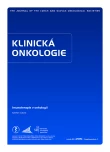Role of Immunotherapy in Pediatric Oncology
Authors:
V. Bajčiová
Authors‘ workplace:
Klinika dětské onkologie LF MU a FN Brno
Published in:
Klin Onkol 2015; 28(Supplementum 4): 38-43
Category:
Generals
doi:
https://doi.org/10.14735/amko20154S38
Overview
Background:
Currently, most children with cancer can be cured with standard therapy (surgery, chemotherapy, radiotherapy). The only limiting factor is its severe acute toxicity and late adverse events. In pediatric oncology, immunotherapy has been delayed but the initial clinical trials of immunotherapy show a good tolerance and promising results, especially in the setting of refractory or recurrent high-risk tumors. In this article, we will discuss a current situation in pediatric oncology, what immunotherapies are being tested in the clinical practice, from monoclonal antibodies, check point inhibitors to tumor vaccines, T-lymphocytes with chimeric antigen receptors, cytokines and innate immunity.
Conclusion:
Immunotherapy is a promising treatment modality for children and adolescents with recurrent high-risk cancer with potential to improve both survival and quality of life. The challenge of developing immunotherapies in pediatric oncology remains – age barriers for using new drugs and a limited number of pediatric clinical studies.
Key words:
pediatric cancer – immunotherapy – monoclonal antibodies – vaccines – cell therapy – cytokines
The author declares she has no potential conflicts of interest concerning drugs, products, or services used in the study.
The Editorial Board declares that the manuscript met the ICMJE recommendation for biomedical papers.
Submitted:
24. 8. 2015
Accepted:
16. 9. 2015
Sources
1. Bajčiová V. Využití imunoterapie v dětské onkologii. Onkológia 2014; 9(1): 34– 38.
2. Mackall CL, Merchant MS, Fry TJ. Immune‑based therapies for childhood cancer. Nat Rev Oncol 2014; 11(12): 693– 703. doi: 10.1038/ nrclinonc.2014.177.
3. Mackall CL, Arceci RJ. Immunotherapeutic targeting in children. Medscape reference, Drugs, Disease and Procedures, March 2012 [online]. Available from: http:/ emedicine.medscape.com/ article/ 991158- overview.
4. Capitini CHM, Otto M, DeSantes B. Immunotherapy in pediatric malignancies: current status and future perspectives. Future Oncol 2014; 10(9): 1659– 1678. doi: 10.2217/ fon.14.62.
5. Galon J, Mlecnik B, Bindea G et al. Towards the introduction of the „immunoscore“ in the classification of malignant tumours. J Pathol 2014; 232(2): 199– 209. doi: 10.1002/ path.4287.
6. Haworth KB, Leddon JL, Chen CHZ et al. Going back to class I: MHC and immunotherapies for childhood cancer. Pediatr Blood Cancer 2015; 62(4): 571– 576. doi: 10.1002/ pbc.25359.
7. Vogelstein B, Papadopoulos N, Velculesa V et al. Cancer genome landscape. Science 2013; 339(6127): 1546– 1558. doi: 10.1126/ science.1235122.
8. Marabelle A, Gray J. Tumor‑ targeted and immune- targeted monoclonal antibodies:going from passive to active immunotherapy. Pediatr Blood Cancer 2015; 62(8): 1317– 1325. doi: 10.1002/ pbc.25508.9. van Dam L, de Zwart VM, Meyer‑ Wentrup FA. The role of programmed cell death‑ 1 (PD‑ 1) and its ligands in pediatric cancer. Pediatr Blood Cancer 2015; 62: 190– 197. doi: 10.1002/ pbc.25284.
10. Wayne AS, Capitini CHM, Mackall CL. Immunotherapy of childhood cancer: from biologic understanding to clinical application. Curr Opin Pediatr 2010; 22(1): 2– 11. doi: 10.1097/ MOP.0b013e3283350d3e.
11. Hatina J. Imunologie nádorů – současný stav a poznatky z 1. mezinárodní konference základní a klinické imunogenomiky. Část II – protinádorová imunoterapie. Klin Onkol 2005; 18(4): 126– 133.
12. Eckschlager T. Má imunoterapie své místo v současné dětské onkologii? Klin Onkol 2003; 16 (Suppl 1): 125– 126.
13. Grupp SA, Verneris M, Sondel PM et al. Immunotherapy for pediatric cancer. Biol Blood Marow Transplant 2008; 14 (Suppl 1): 33– 43. doi: 10.1016/ j.bbmt.2007.10.014.
14. Suzuki M, Curran KJ, Cheung NK. Chimeric antigen receptors and bispecific antibodies to retarget T cells in pediatric oncology. Pediatr Blood Cancer 2015; 62(8): 1326– 1336. doi: 10.1002/ pbc.25513.
15. Thomas DM. RANKL, denosumab, and giant cell tumor of bone. Curr Opin Oncol 2012; 24(4): 397– 403. doi: 10.1097/ CCO.0b013e328354c129.
16. Capitini CHM, Mackall CI, Wayne AS. Immune‑based therapeutics for pediatric cancer. Expert Opin Biol Ther 2010; 10(2): 163– 178. doi: 10.1517/ 14712590903431022.
17. Finkelstein SE, Tiimerman R, McBride WH et al. The confluence of stereotactic ablative radiotherapy and tumor imunology. Clin Dev Imunol 2011; 2011: 439752. doi: 10.1155/ 2011/ 439752.
18. Chou AJ, Kleinerman ES, Krailo MD et al. Addition of muramyl tripeptide to chemotherapy for patients with newly diagnosed metastatic osteosarcoma: a report from the Children’s Oncology Group. Cancer 2009; 115(22): 5339– 5348. doi: 10.1002/ cncr.24566.
Labels
Paediatric clinical oncology Surgery Clinical oncologyArticle was published in
Clinical Oncology

2015 Issue Supplementum 4
- Metamizole vs. Tramadol in Postoperative Analgesia
- Metamizole at a Glance and in Practice – Effective Non-Opioid Analgesic for All Ages
- The Importance of Hydration in Wound Healing
- Obstacle Called Vasospasm: Which Solution Is Most Effective in Microsurgery and How to Pharmacologically Assist It?
- Possibilities of Using Metamizole in the Treatment of Acute Primary Headaches
Most read in this issue
- Side‑ effects of Modern Immunotherapy and How to Solve Them in the Clinics
- Immunotherapy of Urothelial Carcinoma of the Bladder – from BCG Vaccines to Targeted Therapy
- Escape Strategies of Tumors from Immune Surveillence
- The Concept of Immunogenic Cell Death in Antitumor Immunity
